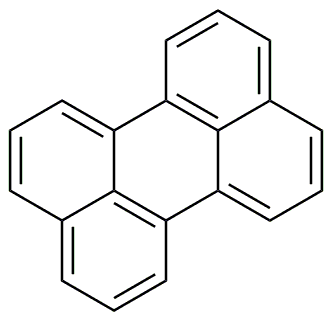Perylene is widely utilized in research focused on:
- Organic Electronics: Perylene is a key component in organic semiconductors, used in devices like organic light-emitting diodes (OLEDs) and organic photovoltaics (OPVs), offering high efficiency and stability.
- Fluorescent Dyes: Its strong fluorescence makes it an excellent choice for fluorescent probes in biological imaging, allowing researchers to visualize cellular processes with high precision.
- Polymer Additives: Perylene derivatives are used to enhance the thermal and photostability of polymers, making them suitable for high-performance applications in coatings and plastics.
- Environmental Monitoring: As a marker for polycyclic aromatic hydrocarbons (PAHs), perylene is used in environmental studies to assess pollution levels in air and water, helping to track contamination sources.
- Nanotechnology: Perylene is incorporated into nanomaterials for applications in sensors and drug delivery systems, leveraging its unique electronic properties to improve performance.
General Information
Properties
Safety and Regulations
Applications
Perylene is widely utilized in research focused on:
- Organic Electronics: Perylene is a key component in organic semiconductors, used in devices like organic light-emitting diodes (OLEDs) and organic photovoltaics (OPVs), offering high efficiency and stability.
- Fluorescent Dyes: Its strong fluorescence makes it an excellent choice for fluorescent probes in biological imaging, allowing researchers to visualize cellular processes with high precision.
- Polymer Additives: Perylene derivatives are used to enhance the thermal and photostability of polymers, making them suitable for high-performance applications in coatings and plastics.
- Environmental Monitoring: As a marker for polycyclic aromatic hydrocarbons (PAHs), perylene is used in environmental studies to assess pollution levels in air and water, helping to track contamination sources.
- Nanotechnology: Perylene is incorporated into nanomaterials for applications in sensors and drug delivery systems, leveraging its unique electronic properties to improve performance.
Documents
Safety Data Sheets (SDS)
The SDS provides comprehensive safety information on handling, storage, and disposal of the product.
Product Specification (PS)
The PS provides a comprehensive breakdown of the product’s properties, including chemical composition, physical state, purity, and storage requirements. It also details acceptable quality ranges and the product's intended applications.
Certificates of Analysis (COA)
Search for Certificates of Analysis (COA) by entering the products Lot Number. Lot and Batch Numbers can be found on a product’s label following the words ‘Lot’ or ‘Batch’.
*Catalog Number
*Lot Number
Certificates Of Origin (COO)
This COO confirms the country where the product was manufactured, and also details the materials and components used in it and whether it is derived from natural, synthetic, or other specific sources. This certificate may be required for customs, trade, and regulatory compliance.
*Catalog Number
*Lot Number
Safety Data Sheets (SDS)
The SDS provides comprehensive safety information on handling, storage, and disposal of the product.
DownloadProduct Specification (PS)
The PS provides a comprehensive breakdown of the product’s properties, including chemical composition, physical state, purity, and storage requirements. It also details acceptable quality ranges and the product's intended applications.
DownloadCertificates of Analysis (COA)
Search for Certificates of Analysis (COA) by entering the products Lot Number. Lot and Batch Numbers can be found on a product’s label following the words ‘Lot’ or ‘Batch’.
*Catalog Number
*Lot Number
Certificates Of Origin (COO)
This COO confirms the country where the product was manufactured, and also details the materials and components used in it and whether it is derived from natural, synthetic, or other specific sources. This certificate may be required for customs, trade, and regulatory compliance.


